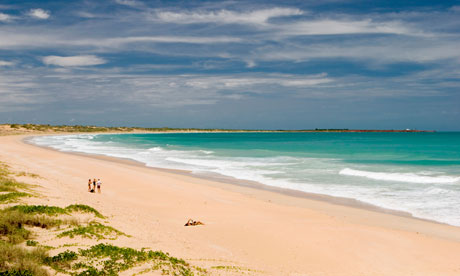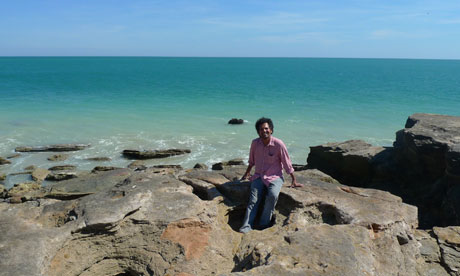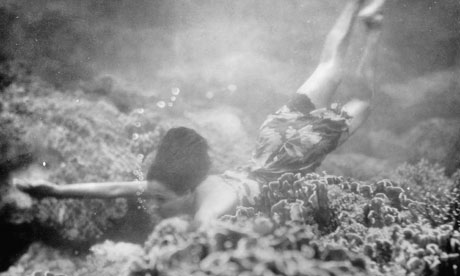
Within minutes of arriving in Broome I find myself knee deep in the deliciously warm waters of the Indian Ocean, just another sun worshipper along the town's fabled Cable Beach. The 22km of powdery, pale-white sand that fringes the calm blue ocean is Broome's biggest draw, and the town's winter population of 15,000 quadruples in the summer, with retired grey nomads and younger backpackers who come to experience the star-filled clear skies and the sheer romance of its remoteness.
On the northwestern tip of Australia, Broome is 1,800km from the nearest city, Darwin, and the gateway to the country's last frontier of pristine wilderness, the Kimberley. One of the most fascinating of all Australian towns, its rich and brutal history is inextricably linked to its precious export. Broome's modern history began in the 1870s, when it was discovered that the waters around the town were home to the Pinctada maxima ? the world's largest pearl oyster. At first it was the shells that were thought valuable ? the mother of pearl was used to make buttons and cutlery and jewellery that would be exported all the way to New York and London ? and the oysters were collected by divers who sailed in and out on pearling luggers. In the town's heyday there were more than 400 boats sailing off the coast. Today the Intombi, built more than 100 years ago, is one of the last remaining pearl luggers afloat; she is owned by Ryan and Amy Risinger, who use her to take travellers for sunset cruises along the beach.

We spend a beautiful afternoon on deck with the sun beating down as the wind fills the sails and blows us onward. Soon the sun is setting; the sea turns wine-dark and the sky looks like it has been smeared in fire and honey. It's hard to imagine what it would have been like for the pearl divers, so great was the contrast between the rather agreeable time I was having ? sipping on a cold drink, admiring the stunning views ? and the appalling conditions that they would have faced. Pearling masters would set sail on luggers with six or seven crew members and one diver who would work six days a week from dawn to dusk bringing shells to the surface. "Imagine the stench!" says Amy, passing another plate of hummus and carrot sticks as "Hotel California" plays over the speakers. "All these guys sleeping on foul-smelling oyster shells?"
The town itself was founded in 1883 and named after the then-state governor, Sir Frederick Napier Broome. There is no building taller than two storeys and there are no traffic lights in the entire town. I wander through Courthouse Market, where you can buy home-made candles while an Aboriginal man plays the didgeridoo. The centre of town is a strange amalgam of tourist-trap bars advertising wet T-shirt contests and luxury boutique pearl showrooms with necklaces costing $185,000.
Around the turn of the 20th century, 80% of the world's finest pearls came from here ? and the trade didn't just transform the town's fortunes but also its population. On Roebuck Bay I come across a statue of a pregnant Aborigine woman, her arms desperately rising out of a wave with a pearl shell in her hand. In Broome's museum I learn more about the history she represents: "blackbirding", the deliberate kidnapping and enslavement of Aborigines to force them to skin dive for pearls, holding their breath for long periods. Pregnant Aboriginal women were believed to make the best divers, as it was thought they had greater lung capacity. I join young white families staring in silence at the chains and shackles, and photographs of grim-faced Aborigines manacled together.

When blackbirding was outlawed, Broome was faced with the challenge of finding others to do the dangerous work of diving for pearls. In 1901 the Australian government passed the Immigration Restriction Act ? which limited the numbers of non-whites coming into the country ? but Broome was given a special exemption and immigrants arrived from China, Japan, Malaysia and elsewhere to work as pearl divers and settle in the town. The legacy of that immigration and early multiculturalism is everywhere in Broome: the town centre is called Chinatown.
Among its best-known restaurants is Matso's, a Broome institution for more than 100 years. The original building was erected in 1900 as a bank, and it operated among opium dens and brothels until a fire destroyed the street of ill repute and the building was relocated to its current location. After stopping there for an evening meal of barramundi I stroll down the road and come across the oldest outdoor cinema in the world, Sun Pictures, which opened in 1916 and is tonight showing a dodgy Jennifer Aniston romcom.
The following day I drive 40km north to Willie Creek Farm ? the only pearl farm offering tours to the public. The all-terrain vehicle ploughs through roads of red dust and the hot summer air is thick with dragonflies as we pass eucalyptus, waxy-leaved fragrant frangipani and mango trees. I sit on a wooden bench as a perky South African describes how they go about creating cultured pearls.
"Basically we take the oyster from the seabed," he says brightly, holding one in his hands, "and then we very carefully open it up and insert a tiny hard ball into its gonads." The male members of the group cross their legs in unison. "Now as you can imagine, guys, the oyster finds this very irritating, and it produces a white gooey nacre which wraps itself around the ball and over a couple of years that is what makes a perfectly round cultured pearl." It seems a trifle cruel to be sexually molesting a mollusc to allow a vain human to have something shiny to dangle from their ears. Already slightly queasy, I'm shepherded into a pearl showroom where seeing the prices charged for these pale white marbles almost causes me to faint.
I reflect on the brutal, poor and masculine world of pearl diving and the refined, luxurious and largely female world of pearl wearing. Beauty and brutality ? both can be found in Broome, a town bathed in sunshine with a heart of darkness. I end my final day in the town where I began, on Cable Beach. The sun is setting ? a red disc slipping behind the sea ? and I lie in the shallows with the ocean's warm water rushing over me. How easy it is to be swept away.
Full Article: http://www.guardian.co.uk/travel/2011/sep/18/broome-australia-beach-pearl
